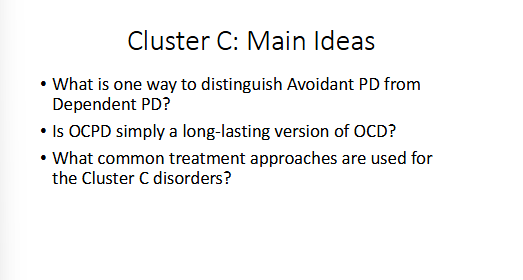Personality Disorders (Cluster B & C)
1/23
There's no tags or description
Looks like no tags are added yet.
Name | Mastery | Learn | Test | Matching | Spaced |
|---|
No study sessions yet.
24 Terms
Cluster B
Historic
Narcissistic
Antisocial
Borderline
Dramatic, emotional, erratic
Histrionic PD
pattern of excessive emotionally and attention-seeking
uncomfortable when NOT the center of attention
inappropriately sexual/seductive
rapidly shifting or shallow emotions
impressionistic speech
easily influenced by others
sees relationships as closer than they are
Histrionic PD : Causes
psychodynamic:
unloving parents —> dramatic displays for help
Cognitive:
believe they are helpless
self-focused and emotional so vague memories force them to rely on others for social cues
Sociocultural:
exaggeration of cultural feminity?
diagnosed less often in less sexualized cultures
behaviors possibly pop up more when it is more acceptable to dress certain ways and feminine behavior shows up
Narcissistic PD
A pervasive pattern of grandiosity in fantasy OR behavior
Exaggerates achievements or is preoccupied with fantasies of power, brilliance
Believes they are special; should only associate with the best
Need for admiration
Sense of entitlement/lack of empathy
Takes advantage of others
Narcissistic PD: Causes
Psychodynamic
Cold, rejecting parents —> defend against feeling unsatisfieed or rejected
Grandiosity convinces they’re self-sufficient
Cognitive:
Overly warm parents —> grandiose self-image
Sociocultural:
Modern Western values promote narcissism?
“I’m special”
“Everyone’s winner!”
Narcissistic PD: Treatments
Psychodynamic:
Work through insecurities and defenses
Cognitive:
Redirect clients to think about others
Reach a more balanced interpretation of criticism
Reduce all-or-nothing thinking
Difficult because clients rarely admit weakness or incorporate others’ feedback
Antisocial PD
18 years or older ( younger —→ conduct disorder)
Repeatedly breaking the law
Deceitful; repeated lying
Impuslivitiy
Involved in many fights
Reckless disregard for safety of self or others
Irresponsibility at work or with finances
Lack of remorse
4x more common in men than women
Different than Psychopathy
Psycopathy Psychopathy
Superficial charm
Lack of empathy
Calculating and manipulative
“Successful” vs. “Unsuccessful”
Antisocial PD: Causes
Psychodynamic:
Absence of parental love —> lack of basic trust
Behavioral:
Antisocial behaviors learned through modeling/unintentional reinforcement from parents
Cognitive:
Hold beliefs that others are not important
Biological:
- Low serotonin —? impulsivity/ aggression
PFC deficits —> lack of empathy?
Less anxiety —? difficulty learning from punishment
Antisocial PD : Treatments
Very limited success
Lack of empathy —> lack of motivation
Cognitive:
Help clients see others’ needs
Group:
Teach responsibility to others
But may actually increase antisocial traits
Learn new techniques from each other
Iatrogenic: if treatment has negative effects (develop new symptoms than they came in)
Borderline
Pattern of unstable relationships
Highly sensitive to potential rejection
Oscillate btw,. idealization and devaluation
Unstable self-image
Rapidly fluctuating affect
Marked impulsivity
Driiving, life foals, sex, financial
Including, suicidality, or self-harm
75% women, 25% men
Female version of antisocial PD?
Borderline PD: Causes
Psychodynamic:
Parental lack of acceptance —> lost self-esteem
Biological:
Overly reactive amygdala
Under-reactive prefrontal cortex
Under-reactive serotonin transporter gene
Sociocultural:
Interaction of biological vulnerability with punishing social environment
invalidating family environment
Children don’t know how to trust their own feelings, rely on others
Don’t develop emotion regulation skills
Borderline PD: Treatments
Dialectical Behavior Therapy (DPT)
Combined CBT and mindfulness.acceptance
Balances acceptance with change
Targets therapy-interfering behaviors first
ex. suicidality, not attending sessions
Individual therapy and skills groups simultaneously
promotes validation of clients
Teaches emotion regulation skills
Practice of interpersonal skills
Cluster B main ideas:
How can you distinguish Antisocal PD and Borderline PD?
gender differences
How can you distinguish Narcissistic PD from Histrionic PD?
Narcisitic using others for yourself and Histrionic no reliance for self importance and more stand alone
What is the role of culture or context in the Cluster B disorder?
messages of society might be telling us may be internalized
Cluster C
Avoidant
Dependent
Obsessive-compulsive
“Anxious or fearful”
Avoidant PD
Pervasive social inhibition
Avoid jobs requiring social interaction
Feelings of inadequacy
Avoids jobs requiring social interaction
Inhibition in social situations
Hypersensitivity to negative evaluation
Spend a lot of time worrying about social situations
Avoidant PD Causes
Psychodynamic:
Early bowel or bladder accidents —> punishment by parents —> general social shane
Cognitive:
Early harsh rejection —> expectation/ fear of it from others
Behavioral:
Fail to develop social skills
Because they avoid social situations
Avoidant PD : Treatments
Difficult for clients to trust therapist
Psychodynamic:
Help clients resolve early-rooted conflicts
Cognitive:
Challenge distressing beliefs, tolerate anxiety I social situations, improve self-image
Behavioral:
Teach social skills
Dependent PD
Pervasive, excessive need to be taken care of
Leads to submissive, clinging behavior
Depend on others for most decisions, from what to wear to whom to marry
Difficulty initiating projects due to lack of self-confidence
Fears of separation
Rarely expresses disagreement
Volunteers to of unpleasant things for others
Urgently seeks new relationships if old ones terminate
Dependent PD: Causes
Psychodynamic:
Conflicts during oral stage —> need for nurturance
Early parental loss —> separation issues
Parental over-involvement —> increased dependency
Cognitive:
Maladaptive beliefs: “ I am helpless” and “I must find someone to protect me”
Behavioral
Parents reward clinging and punish independence
Dependent PD: Treatments
Psychodynamic:
Transfer dependency needs to therapist in order to work through
Cognitive
Challenge assumptions of helplessness
Behavioral:
Assetiveness training; group therapy
Biological:
Antidepressants to manage symptoms
Obsessive-Compulsive PD
Preoccupation with orderliness, perfectionism, and interpersonal control
Focus on details to the exclusion of major point of activity
Excessively devoted to work
Miserly attitude toward money
Leads to inflexibility and inefficiency
Overly scrupulous in matters of morality
Many projects left unfinished
OCPD: Causes
Psychodynamic:
Overly harsh toilet training (anal retentive) —> anger and resentment —> efforts to control anger
Cognitive:
Holds all-or-nothing beliefs like “ if it;s not done perfectly, it shouldn’t be done at all”
Behavioral:
“Doing things very well often leads to a lot of praise and rewards; many reinforce excessive detail-orientation
e.g.: graduation students
OCPD: Treatments
Psychodynamic:
Psychodynamics:
Help clients recognize and accept their underlying insecurities
Help clients take risks
Cognitive:
Challenge dichotomous thinking, procrastination, perfectionism, and worrying

?
no
psychodynamic